The Palace of Versailles: A Triumph of Elegance and Grandeur

|
|
Painting of Louis XV in coronation attire behind 18th century bronze & crystal chandelier The Mercury Room, King's State Apartment |
The Palace of Versailles (Château de Versailles), located just southwest of Paris, France, is more than a historical relic; it is a living testament to France's cultural, artistic and political heritage. Its beauty and significance continue to captivate the world, serving as a reminder of a bygone era when kings and queens ruled with unparalleled grandeur. Versailles is not just a palace; it is a symbol of France's enduring commitment to excellence in art, architecture and history. It remains an essential destination for those seeking to immerse themselves in the splendor and grace of France's royal past. This is our photo story of riding the train from Paris and exploring the Palace turned Museum of Versailles.
Watch "London Paris Eurostar Château de Versailles Musée du Louvre la Tour Eiffel & Paris Zurich TGV Lyria"
Watch a video presentation of the part of our Europe trip that covers Versailles (link to full video).
A Journey Through Time: Riding the Rails from Paris to Versailles
The journey from Paris to Versailles starts with train rides. The departure point for Versailles is Gare Montparnasse (map), a major railway station in the heart of Paris known for its striking architecture and bustling atmosphere. In our case, our B&B in Paris is next to Gare de l'Est station from where a train takes us to Montparnasse in half an hour. We change in Montparnasse into one of the many regional commuter trains headed to Versailles-Chantiers.

|
| Montparnasse Train Station, Paris |
One of the most convenient routes is the RER C (Réseau Express Régional) commuter train. The RER C Line, which begins at several stations in Paris, including the famous Musée d'Orsay and the Eiffel Tower-adjacent Champ de Mars-Tour Eiffel station, makes stops at several key Versailles stations, including Versailles-Château, Versailles-Chantiers and Versailles-Rive Gauche. Depending on the exact departure point in Paris, the journey takes approximately 30 to 40 minutes.

|
| Aboard the Montparnasse to Versailles-Chantiers Train |
As we board the train, we find ourselves among a diverse mix of passengers, from tourists eager to explore Versailles to local commuters heading to work or going about their daily lives. The train cars themselves offer a comfortable and efficient mode of transportation.
Once the train arrives in Versailles, we are just a short walk away from the Palace of Versailles and its stunning gardens. As we step onto the platform, we are greeted by the charming atmosphere of this historic town.

|
| City Hall of Versailles |
As we exit the station and make our way toward the palace, we quickly realize why Versailles has enchanted visitors for centuries. The Palace of Versailles, a breathtaking blend of Baroque and Rococo architecture, is a true masterpiece. The Hall of Mirrors, the grand apartments of the kings and queens and the lush gardens are just a few of the highlights awaiting our exploration.

|
| Palace of Versailles |
Palace of Versailles
To the Glory of France (a toutes les gloires de la France)

|
| The iconic Hall of Mirrors |
One of the most striking features of Versailles is its remarkable architecture. The palace is designed in the classic French Baroque style, characterized by its grand symmetrical façades, ornate decorations and majestic proportions. It was built and expanded over the course of several decades during the 17th and 18th centuries and served as the principal royal residence and main seat of power for the French monarchy until the French Revolution in 1789. The palace witnessed the signing of several significant treaties, including the Treaty of Versailles that ended World War I in 1919. Furthermore, it played a central role during the French Revolution when it became a symbol of royal excess, ultimately leading to the abolition of the monarchy.
History of Versailles Palace

|
| Panoramic view of the Palace of Versailles (composite) |
The original structure on the site of the palace was a hunting lodge built for King Louis XIII in the early 17th century. His son, Louis XIV, had the lodge expanded and transformed into a lavish palace in the 1660s and 1670s.
Louis XIV wanted to create a palace that would reflect his own absolute power and the glory of the French monarchy. He commissioned some of the greatest architects, artists and landscapers of the time to work on Versailles. The result was this truly awe-inspiring complex.

|
| Outer entrance to the Palace of Versailles |
Louis XIV and his court moved into Versailles in 1682 and the palace remained the center of French political and social life for over a century. It was the scene of countless lavish balls, banquets and other events and the French aristocracy competed fiercely to win the king's favor and spend time at his court.

|
| One of the visitor information boards |
In 1789, the French Revolution forced the royal family to flee Versailles and return to Paris. The palace was looted and vandalized by revolutionaries and much of its furniture and artwork was destroyed. However, the palace itself survived and eventually restored, converted to a museum and opened to the public in the 19th century by King Louis-Philippe I.

|
| Queue for tickets |
Here is a brief timeline of the creation of the Palace-Museum of Versailles:
The Palace of Versailles has been open to the public ever since its inauguration in 1837 as a museum. It is a UNESCO World Heritage Site and welcomes over 7.5 million visitors annually. Tourists from all over the world come to marvel at its stunning architecture, explore the opulent apartments of the kings and queens, wander through the meticulously maintained gardens and relive history within its walls. It is a reminder of the grandeur and luxury of the French court during l'Ancien Régime and one of the most popular tourist attractions in France and a valuable educational resource for visitors from all over the world. The palace is also an official residence of la République Française.

|
| A tour guide leading tourists into the Vestibule of the Royal Chapel |
King Louis XIV

|
|
|
Louis XIV of France (1638-1715), also known as Louis the Great (Louis le Grand) and the Sun King (le Roi Soleil), was King of France from 1643 until his death in 1715. He was one of the most important and influential as well as the longest-reigning of monarchs in European history. His reign, marked by a period of great cultural and political achievement, characterizes an era when the French monarchy reached the zenith of its power and prestige.

|
| The Death of Louis XIV: Painting displayed at the La Création du Musée room |
Louis XIV was born in Saint-Germain-en-Laye, France, on September 5, 1638. He was the son of King Louis XIII and Anne of Austria. Louis XIV's father died when he was only four years old and he ascended to the throne under the regency of his mother and Cardinal Mazarin.
Louis XIV was a very intelligent and ambitious ruler. He was determined to make France the most powerful country in Europe and he succeeded in doing so. Under his leadership, France expanded its territory and became a major economic and military power.
Louis XIV was also a great patron of the arts. He supported many of the greatest artists and writers of his time, including Molière, Racine and Lully. He oversaw the construction of the Palace of Versailles as one of the most magnificent palaces in the world.
Louis XIV died on September 1, 1715, at the age of 76. He was succeeded by his great-grandson, Louis XV.
A brilliant military strategist, a shrewd politician and a great patron of the arts, Louis XIV's reign marked the beginning of the Golden Age of France and his legacy continues to be felt today.
A complex and controversial figure, Louis XIV was both admired and feared by his contemporaries.
Queen Marie Antoinette

|
| c.1770 portrait of Marie Antoinette by Joseph Ducreux displayed at the Palace of Versailles |
Marie Antoinette, the last Queen of France before the French Revolution, is a figure shrouded in both fascination and controversy. Born an Archduchess of Austria, she married King Louis XVI of France, becoming Queen at the tender age of 19. Marie Antoinette was renowned for her extravagance and love of fashion, which contributed to her being widely criticized and labeled as out of touch with the hardships of the common people. However, she also endured immense personal challenges, including political turmoil, the pressures of royal duty and her role in producing an heir to the throne. Her infamous phrase "Let them eat cake," though likely falsely attributed, has come to symbolize the monarchy's insensitivity. Despite her tumultuous legacy, Marie Antoinette's life and fate, including her tragic end at the guillotine during the French Revolution, have made her a compelling and enduring historical figure.
King Louis-Philippe I

|
| c.1840 portrait of Louis Philippe I by Franz Xaver Winterhalter displayed at the Palace of Versailles |
King Louis-Philippe I, known as the "Citizen King," was a pivotal figure in the tumultuous history of France during the 19th century. He ruled as the last monarch of France from 1830 to 1848 during the July Monarchy, which began with the July Revolution of 1830. Louis-Philippe's reign marked a shift towards constitutional monarchy, emphasizing his image as a ruler of the middle class. His reign was characterized by relative stability, economic progress and the expansion of the railways in France. However, he faced growing opposition and discontent from both republicans and royalists. In 1848, amidst widespread unrest and revolutionary fervor, he abdicated the throne in favor of his grandson and went into exile in England. King Louis-Philippe's reign reflects the complexities of 19th-century French politics, where the struggle for power and legitimacy was a defining theme.
Top Attractions of the Palace of Versailles

|
| A 3D model in the La Création du Musée room orients tourists to the vast palace complex |
The Palace of Versailles is a dazzling example of majestic Baroque architecture and offers visitors a glimpse into the lavishness and extravagance of the French court during the 17th and 18th centuries. It is a vast complex of magnificent buildings, gardens and fountains. It is impossible to see everything in one visit ( download a large visitors' map of Palace of Versailles and also check out this Floor Plan Map of the Upper Floor).
However, here are some of the most important and popular places to visit in the Palace of Versailles in the rough order of our own visit.
Equestrian Statue of King Louis XIV

|
| Sculpture of King Louis XIV in front of the Palace of Versailles |
The equestrian sculpture of Louis XIV, situated in the vast courtyard known as the Place d'Armes in front of the Palace of Versailles, is a remarkable work of art that pays homage to the monarch's image of strength, power and authority. The statue features Louis XIV mounted on a horse, both depicted in grandiose proportions. The king is shown wearing regal attire and an elaborate wig reflecting the fashion of the time.
The sculpture was designed by Pierre Cartellier originally for the Place de la Concorde in Paris. Unfortunately Cartellier did not get to see the finished statue, passing away when just the horse was completed.
The Royal Opera

|
|
Royal Opera of Versailles Adots215, CC BY-SA 4.0, via Wikimedia Commons |
The Ópera real de Versalles (Opéra du château de Versailles) is the main theatre and opera house of the palace. Designed by Ange-Jacques Gabriel, it is also known as the Théâtre Gabriel. The interior decoration by Augustin Pajou is constructed almost entirely of wood, painted to resemble marble in a technique known as faux marble. The excellent acoustics of the opera house are at least partly due to its wooden interior.
The Royal Opera was built between 1769 and 1770 and inaugurated on May 16, 1770 for celebrating the wedding of Duke of Berry, Dauphin of France (heir apparent to the French crown), the future King Louis XVI then aged 15 to Marie-Antoinette, Archduchess of Austria, aged 14.
The opera house was designed to be the most luxurious and impressive opera house in the world. It could seat up to 6,700 people and it was decorated with the finest materials, including marble, gold and silk.
The Royal Opera was used for a variety of purposes, including operas, ballets and concerts. It was also used for state ceremonies, such as the coronation of King Louis XVI and the marriage of Napoleon Bonaparte to Marie Louise of Austria.

|
|
Ceiling of Royal Opera of Versailles Kipp Jones from Atlanta, US, CC BY 2.0, via Wikimedia Commons |
The Royal Opera hosted numerous performances for the royal family and their guests and continues to be used today for operas, ballets and concerts.
The Honor Gate and the Golden Fence
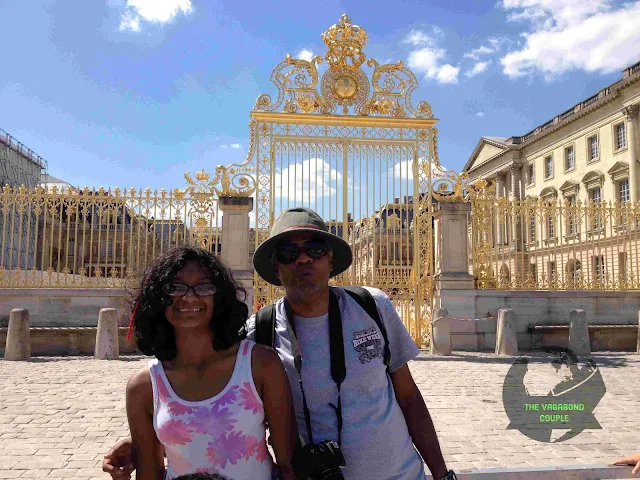
|
| The Honor Gate |
The Royal Gate (grille royale), also known as the Honor Gate (la grille d'honneur) is a beautiful wrought iron gate that was completed in 1684. The gate is decorated with the royal coat of arms and the sunburst emblem of Louis XIV, the Sun King.

|
| The Honor Gate |
The Honor Gate was one of the main entrances to the palace used by the king and his court to enter the palace grounds. The gate was also used for special occasions such as the arrival of foreign dignitaries.

|
| The Honor Gate |
The Golden Fence (Grille d'Or) is a wrought iron fence that surrounds the palace grounds. The fence was completed in 1682. The fence, like the gate, is decorated with the royal coat of arms and the sunburst emblem of King Louis XIV.

|
| The Golden Fence |
The Golden Fence is one of the most impressive fences in the world. It is over 3 kilometers (2 miles) long and 4 meters (13 feet) high. The fence is made up of over 30,000 individual iron bars.

|
| The Golden Fence |
The Golden Fence was built to protect the Palace of Versailles from intruders. It was also built to impress visitors to the palace.
The Royal Chapel
The Royal Chapel (Chapelle royale de Versailles) is a Roman Catholic chapel. It is one of the most lavishly decorated chapels and important religious buildings in the world.

|
| The Royal Chapel (composite) |
The Royal Chapel was built between 1699 and 1710 and inaugurated on May 5, 1710. The chapel was designed by Jules Hardouin-Mansart. It is decorated with marble, gold and other precious materials.
The Royal Chapel is 70 meters (230 ft) long and 25 meters (82 ft) wide. It is divided into two floors. The upper floor was reserved for the king and his family, while the lower floor was open to the public. We will get a view from the upper floor later in this tour.
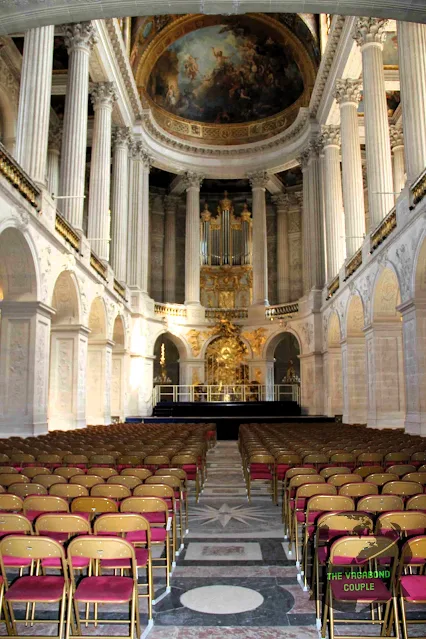
|
| The Royal Chapel |
The Royal Chapel was used for a variety of religious ceremonies including weddings, baptisms and funerals. It was also used for state ceremonies such as the coronation of King Louis XVI and the marriage of Napoleon Bonaparte to Marie Louise of Austria.
Here are some of the most notable features of the Royal Chapel:
- The main altar is made of white marble and is decorated with gold and precious stones.
- The pulpit is made of ebony and ivory and it is decorated with bas-reliefs depicting scenes from the Bible.
- The choir stalls are made of carved wood and are decorated with the coats of arms of the French monarchy.
- The ceiling is painted with a fresco of the Assumption of the Virgin Mary.
The Museum of Creation of Palace of Versailles
King Louis-Philippe I restored and converted the Palace of Versailles into a museum as a way to promote national unity and to reconcile different factions that had emerged during the French Revolution. He wanted the museum to be a place where all French people could come together to learn about their shared history and culture. Today the palace-turned-museum continues to offer a unique glimpse into the lives of the French people and the events that have shaped their country.
The La Création du Musée room is dedicated to the history of the palace itself. The room contains a variety of exhibits that tell the story of the palace's founding and development. These exhibits include paintings, sculptures, furniture and documents. The room also has a number of interactive exhibits that allow visitors to learn about artifacts and the role of the palace in French history.

|
| Replica of Equestrian Statue of Louis XIV at the Museum of Creation |
An excellent 3D model of the palace and a remarkable painting depicting the death of Louis XIV are among the exhibits in this room.
Monkeys riding goats
Among the items displayed in the Museum of Creation are whimsical and charming lead sculptures of monkeys riding on goats. These are survivors from the series of Aesop's Fables Lead Sculptures. The 38 sculptures of the series depicted parables by the ancient Greek storyteller Aesop.
The sculptures were created between 1672 and 1677 by four French sculptors: Jean-Baptiste Tuby, Etienne Le Hongre, Pierre Le Gros and brothers Gaspard and Balthazard Marsy of Cambrai. The sculptures were originally located in the Labyrinth of Versailles (see below) around a statue of Aesop.

|
| Monkeys riding goats: Aesop's Fables Lead Sculptures from the Labyrinth |
The Aesop Fables lead sculptures were the only sculptures in the world to depict Aesop's fables in such a comprehensive way. The sculptures, notable for their high quality and artistry, were created using a variety of techniques including casting, carving and welding. Here are some of Aesop's Fables that the sculptures depicted:
- The Fox and the Crow
- The Tortoise and the Hare
- The Town Mouse and the Country Mouse
- The Ant and the Grasshopper
- The Dog and the Bone
- The Lion and the Mouse
- The Boy Who Cried Wolf
The Destroyed Labyrinth of Versailles
The Labyrinth of Versailles (Bosquet du Labyrinthe) was a fascinating and whimsical feature of the Gardens of the Palace of Versailles during the reign of King Louis XIV in the late 17th century. This labyrinth was designed as a part of the palace's extensive gardens, providing a place for leisure, amusement and contemplation. It consisted of a network of hedged pathways, topiaries and fountains, which visitors could explore and enjoy.
The labyrinth was designed in the tradition of classical gardens, symbolizing the journey of life and the search for wisdom. It was an intricate and enchanting creation, meant to delight and surprise guests with its winding paths and hidden nooks. At its center stood a statue of Aesop, the ancient Greek storyteller known for his fables. The Aesop's Fables Lead Sculptures were placed strategically around the labyrinth.
The Labyrinth of Versailles was a place where visitors could temporarily escape the rigid formalities of court life and lose themselves in a world of enchantment. However, the Labyrinth was subsequently replaced with the Queen's Grove (Bosquet de la Reine) of trees and fountains that was once a private garden for Queen Marie Antoinette. Despite its demolition, the labyrinth remains an intriguing part of the history of the Palace of Versailles and its gardens.
Painting of Louis-Philippe I and mini equestrian statue of Louis XIV
Also displayed at the Museum of Creation is a large painting depicting King Louis-Philippe I surrounded by his five sons leaving the palace through the Honor Gate after a military review in the courtyard on June 10, 1837.
There is a small bronze replica of the great equestrian statue of Louis XIV in front of the painting.

|
| Painting of King Louis-Philippe I & sons, and replica of Equestrian Statue of King Louis XIV |
Queen Marie Antoinette and two children walking in the Park of Trianon
A beautiful painting named "Queen Marie Antoinette of France and two of her Children Walking in the Park of Trianon" is among the exhibits of the Museum of Creation. It was painted in 1785 by the Swedish artist Adolf Ulrik Wertmüller.

|
|
Queen Marie Antoinette of France and two of her Children Walking in the Park of Trianon Painting by Adolf Ulrik Wertmüller |
The painting depicts Marie Antoinette walking in the Petit Trianon (see below) with two of her children: the dauphin Louis Joseph and his younger sister Marie-Thérèse Charlotte. The scene is set against the backdrop of a meticulously landscaped garden, complete with lush greenery, meandering paths and classical statuary. The queen and her children are elegantly attired in 18th-century royal fashion exuding an air of sophistication and serenity.
Marie Antoinette, as the queen of France during a tumultuous period in history, remains a controversial and iconic figure. Her extravagant lifestyle, often symbolized by her legendary love for fashion and luxury, made her both a target for criticism and a subject of fascination. This painting, however, is notable for providing a glimpse into a more private and maternal aspect of her life revealing her love for her children and the enjoyment of the idyllic Trianon estate. It beautifully captures the spirit of her intimate escapes from the formalities of the French court and serves as a poignant reminder of the complex life of Marie Antoinette, a queen who, despite her regal status, sought moments of respite and family time in the tranquil gardens of Trianon.
The painting is also notable for its historical significance. It was painted just four years before the French Revolution and it captures the queen's carefree lifestyle before the revolution began.
The Palace of Trianon, nestled within the vast estate of Versailles, was one of Marie Antoinette's favorite retreats. It provided her with respite from the formalities of the Palace of Versailles, offering a more relaxed and intimate environment where she could escape the demands of court life. Trianon consisted of the Grand Trianon and the Petit Trianon, with the latter serving as a private residence for the queen.
Marie Antoinette famously used the Petit Trianon to escape from the grandeur and protocol of Versailles. She devoted significant effort to transforming its gardens allowing her a semblance of a simpler, rural life.
Louis Garnier's Le Parnasse français sculpture
Le Parnasse français (The French Parnassus), a bronze group by Louis Garnier, is a tribute to French artists, musicians and writers of the 17th and 18th centuries. In Greek mythology, Mount Parnassus in central Greece is the home of the nine Muses who are the goddesses of the arts and sciences. Mount Parnassus is thus also the mythological home of the creative arts, music and poetry.
The French Parnassus is over 2 meters (6 and half feet) tall and depicts Apollo, the Greek god of the arts, seated on Mount Parnassus surrounded by the nine Muses. Below them are statuettes of some of the most famous French artists and musicians of the time, including Molière, Racine, Corneille, Lully, La Fontaine and Boileau.

|
| "Le Parnasse français" sculpture by Louis Garnier |
The Le Parnasse français sculpture was unveiled in 1732 and was immediately acclaimed as a masterpiece. It is one of the most iconic works of art in the palace and located next to the first floor landing of the Marble Staircase.
The Marble Staircase
The Marble Staircase (Escalier de Marbre) connects the first floor of the palace ("ground floor" to Europeans) to the Royal Apartments upstairs.

|
|
The Marble Staircase and the Le Parnasse français Photo: Jorge Láscar via Flickr |
The staircase is a double-revolution design, consisting of two gracefully sweeping flights of stairs that spiral around a central landing. This symmetrical layout is both functional and visually striking. The balustrades are adorned with exquisitely detailed and gilded wrought-iron railings showcasing the Baroque taste for ornamentation.

|
| The Marble Staircase |
True to its name, the Marble Staircase is constructed from various types of marble, including white and gray, meticulously selected for their visual impact. The use of marble not only adds to the staircases' grandeur but also reflects the luxury and wealth of the French monarchy.

|
| The Marble Staircase |
The Marble Staircase is not just a decorative feature but also a historical one. During the reign of Louis XIV, the staircase served as the principal entrance to the King's State Apartments. Ambassadors, dignitaries and the king himself would ascend or descend the stairs as they moved between various parts of the palace. There is a great view of the gardens from the second floor landing of the staircase at the doors to the King's apartment.

|
| View of the Gardens from upper floor landing of the Marble Staircase |
Louis XIV Protector of the Academy
A remarkable painting named "Louis XIV Protector of the Academy" by Henri Testelin is displayed on the wall at the landing of the first flight of the luxurious stairs of Marble Staircase. The painting depicts Louis XIV as the patron of the Royal Academy of Painting and Sculpture.

|
| "Louis XIV Protector of the Academy" by Henri Testelin |
The painting was commissioned by the Academy in 1667 and was completed in 1668. In the painting, Louis XIV is seated on a throne holding the Scepter of Charles V (also known as the scepter of Charlemagne, see below). He is surrounded by allegorical figures representing the arts and sciences. In the foreground, a figure representing Painting is offering a crown to Louis XIV. In the background, a figure representing Architecture is holding a plan of the Palace of Versailles.

|
| "Louis XIV Protector of the Academy" by Henri Testelin |
The painting is a celebration of Louis XIV's patronage of the arts and sciences. It is also a symbol of the king's power and prestige. The painting's large size and its original location in the Academy's meeting room made it a powerful statement of the king's commitment to the arts. The painting is also notable for its realism. Louis XIV is depicted in a realistic manner without any idealization. The artist, Henri Testelin, was known for his portraits of the French court and he was able to capture Louis XIV's likeness with great accuracy.
The Sceptre of Charlemagne (Scepter of Charles V)
The Scepter of Charles V, also known as the scepter of Charlemagne, frequently appears in royal portraits. It is one of the most important and symbolic objects of French regalia and a masterpiece of Gothic art and craftsmanship. The scepter is made of gold and decorated with precious stones and pearls surmounted by a statuette of Charlemagne, the first Holy Roman Emperor.

|
| Scepter of Charles V displayed at the Louvre |
The scepter was made in 1364 for the coronation of King Charles V of France. It was commissioned by Charles's mother Joanna of Bourbon who wanted to create a symbol of the French monarchy's legitimacy and its ties to the Carolingian dynasty.
The scepter was used in the coronation ceremonies of French monarchs from Charles V to Charles X in 1825. It was also used in other important state ceremonies, such as the opening of the Estates-General.
The scepter is currently on display at the Louvre Museum in Paris.
Here are some of the key features of the Scepter of Charles V:
- The shaft of the scepter is made of gold and is decorated with fleurs-de-lis and knots.
- The knop of the scepter is decorated with three scenes from the life of Charlemagne: his coronation, his victory over the Saxons and his death.
- The statuette of Charlemagne at the top of the scepter is also made of gold and is wearing a crown and imperial robes.
The Marble Gilded Door
We come across our first of the numerous gorgeous doors of the palace on our way from the Marble Staircase towards the Hallway of the Kings.

|
| A marble golden door |
The door is made of white marble and is decorated with gilt bronze sculptures and reliefs. The sculptures depict various figures from classical mythology, including Hercules, Mercury and Venus. The reliefs depict scenes from the life of King Louis XIV.

|
| A marble gilded door |
Doors like this can be found throughout the palace, leading to various rooms and apartments. Crafted with meticulous attention to detail, they are notable for their use of high-quality materials and elaborate ornamentation. They typically feature finely carved marble panels that are framed by gilded bronze or brass. The gilding, often applied to the door's handles, hinges and decorative motifs, adds a layer of luxury and elegance to the design. They are often embellished with intricate patterns, floral motifs and scenes from classical mythology, enhancing the visual appeal and historical significance of the palace's interior spaces. We will continue to come across such ornate doors as we proceed through the hallway of the kings to the vestibule of the chapel and beyond.
The Hallway of the Kings

|
| The Kings at Hall of the Kings (animated gif) |
The Hallway of the Kings (Galerie des Rois) is a long hall located on the second floor (piano nobile) of the palace's central body. It runs parallel to the Hall of Mirrors.

|
| Hallway of the Kings |
The hall is 105 meters (344 ft) long and 13 meters (43 ft) wide. It is lined with 17 busts of French kings covering a period of 1,300 years from Pharamond (c.370-426), the legendary founder of the Frankish monarchy, to Louis XIV (1638-1715).

|
| Hallway of the Kings |
The Hallway of the Kings was built between 1682 and 1687. It was designed by Jules Hardouin-Mansart and is decorated with marble, gold and other precious materials.

|
| Hallway of the Kings |
The Hallway of the Kings was used for a variety of purposes, including ceremonies, receptions and balls. It was also used as a place for the king to meet with his ministers and advisors.
The Vestibule Of The Royal Chapel

|
| Vestibule of Royal Chapel (composite) |
The Vestibule of the Royal Chapel (Salon de la Chapelle) is a striking and historically significant architectural space that serves as the entrance to the palace's majestic chapel. It is located between the Royal Chapel and the Queen's State Apartment.
The vestibule, which precedes the chapel, acts as an introductory area where visitors and attendees of royal ceremonies would gather before entering the main sanctuary. It measures 22 meters long, 11 meters wide and 11 meters tall and has 16 Corinthian columns.
The marble statue "Royal Magnanimity" (La Magnanimité Royale) by Jacques Bousseau on one side of the vestibule draws immediate attention. It was commissioned by King Louis XIV in 1726 and completed in 1730. The statue is a representation of the virtue of magnanimity, which is defined as the quality of being noble, generous and forgiving. It depicts a female figure wearing a flowing robe and a crown. She is holding a sceptre in her right hand. Her left hand is open as if to offer forgiveness. At her feet is a lion, which is a symbol of strength and courage, resting his paws on cornucopia. It is a reminder that even the most powerful people should be willing to forgive those who have wronged them. Other notable features of the Magnanimité statue:
- The figure is standing in a contrapposto pose, with her weight on her right leg. This creates a sense of movement and dynamism.
- Her face is serene and her expression is one of compassion.
- The sceptre is a symbol of her authority and power.
- The open hand is a gesture of forgiveness.
- The lion is a symbol of strength and courage.
- The cornucopia is a symbol of abundance.

|
| "Royal Magnanimity" by Jacques Bousseau |
"Royal Magnanimity" is a masterpiece of Baroque sculpture. It is well-proportioned and beautifully executed. The use of allegory and symbolism makes the statue a powerful and moving work of art.
On another side of the vestibule stands the Baroque masterpiece statue "Glory holding the portrait of Louis XV" (Gloire tenant le portrait de Louis XV) by artist and sculptor Antoine Vassé. Paying tribute to King Louis XV, the statue depicts a female figure personifying Glory. She holds a portrait of Louis XV with her left hand. This artistic representation symbolizes the idea of divine favor and praise directed towards the king. During the 18th century, monarchs often sought to legitimize their rule through the association with divine or celestial themes and this statue serves as an example of such iconography.

|
| "Glory holding a portrait of King Louis XV" by Antoine Vassé |
The "Glory holding the portrait of Louis XV" statue is a visual centerpiece of the vestibule that sets the tone for the spiritual and ceremonial atmosphere within the chapel itself. It reinforces the idea of divine approval of the king's rule and the role of religion in the court of Louis XV.
Architectural features of the vestibule include towering marble columns, richly gilded marble doors and decorations and intricate stucco work. The marble floor is made of white marble and is inlaid with a complex geometric design made up of squares, triangles and circles and is decorated with a variety of floral and geometric motifs. The floor is also decorated with the coat of arms of France and a mosaic of 18,000 fleurs-de-lis, the lily flower symbol of French monarchy.

|
| Vestibule of Royal Chapel |
Mighty gilded doors, framed in decorated marble walls and Corinthian columns, open into the second floor of the Royal Chapel next to the vestibule. This was the Royal Gallery (King’s Gallery). The king and royalty attended mass from here.
Compared with our prior view of the chapel from the first floor, the resplendent ceiling and Corinthian columns of the chapel are in closer proximity of the second floor balcony of the King's Gallery.

|
| The Royal Chapel seen from the King's Gallery |
Bright sunlight coming in through three great windows illuminates the vestibule in daylight.

|
| The Vestibule of the Royal Chapel |
The ceilings of the vestibule are adorned with magnificent frescoes depicting religious and royal themes serving as a prelude to the visual splendor of the chapel beyond.

|
|
|
The vestibule was designed by architect Jules Hardouin-Mansart and built between 1699 and 1710. It was restored in the 19th century.
The King's State Apartment
The King's State Apartment at the Palace of Versailles was the private residence of the French king. It is located upstairs and consists of a suite of seven rooms decorated lavishly in Baroque style with marble, gold and painted ceilings.

|
| The King's bed in the Mercury Room of Grand Apartment of the King |
The Grand Apartment of the King was used for a variety of purposes, including official ceremonies, private dining and the king's personal use. The suite of rooms was the King's official residence.
Hercules Room, King's Apartment
The Hercules Room, also known as the Salon of Hercules (Salon d'Hercule), is a large reception hall located in the King's Apartment. The room is named after the Greek hero Hercules, the entire ceiling being decorated with the painting "The Apotheosis of Hercules" (Apothéose d’Hercule) depicting Hercules being deified by Olympus. The painting was created by François Lemoyne and it is considered to be one of the masterpieces of French Baroque art.
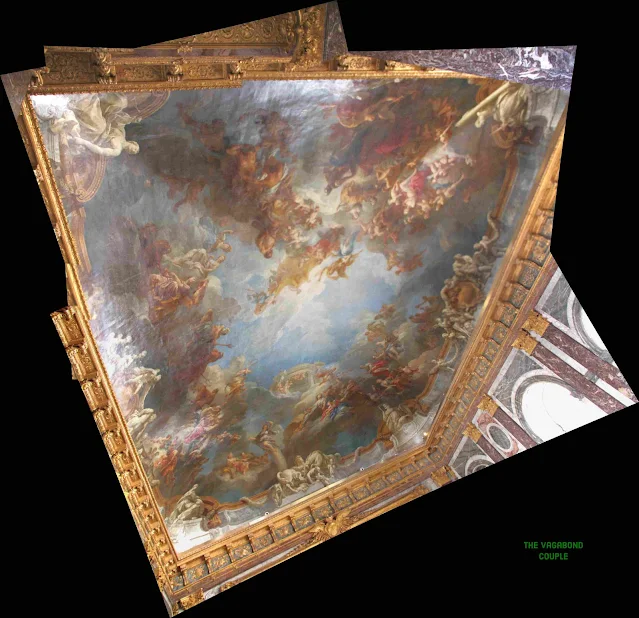
|
| "The Apotheosis of Hercules" by François Lemoyne on ceiling of Hercules Room (composite) |
The painting above the fireplace is "Rebecca at the Well" by Paolo Veronese.

|
| "Rebecca at the Well" by Paolo Veronese, Hercules Salon, Grand Apartment of the King |
The famous painting "Feast in the House of Simon" also by Paolo Veronese is on the other end of the room. Due to the size of this painting, it has been shuttled between the Louvre and the Palace of Versailles a couple of times.

|
| "Feast in the House of Simon" by Paolo Veronese, Hercules Salon, Grand Apartment of the King |
The room was commissioned by King Louis XIV in 1682 and it was designed by Jules Hardouin-Mansart.

|
| Hercules Room, King's Apartment |
The room was completed in 1736 and it was used by Louis XIV and his successors for a variety of purposes, including receptions, balls and concerts.
The Abundance Room, King's Apartment
The Abundance Room (Salon de l'Abondance) is a small antechamber located in the King's Grand Apartment. It measures only 8.65 meters by 7.56 meters but is gorgeously decorated in green and gold.
.jpg)
|
| Abundance Room, King's Apartment (composite) |
The room is also known as the "Drawing Room of Plenty". It is located in the north-east corner of the King's Grand Apartment. The room is accessible from the Salon d'Hercule and it opens onto the Salon de Vénus.

|
| Abundance Room, King's Apartment |
The ceiling is painted with the fresco of "the Abundance of the Earth" by Jean-Baptiste Jouvenet. The fresco depicts a variety of agricultural scenes, including harvesting, threshing and winemaking.

|
| "The Abundance of the Earth" by Jean-Baptiste Jouvenet, fresco on ceiling of Abundance Room |
The room was used by King Louis XIV to receive guests and to hold private meetings. It was also used to display the royal collection of precious objects, including silver vases, gems and medallions.

|
| Abundance Room, King's Apartment |
The room was designed by Jules Hardouin-Mansart and completed in 1710. It is decorated with a variety of materials, including marble, gold and precious stones.

|
|
|
The Venus Room, King's Apartment
The Venus Room (Salon de Vénus) was designed and decorated by Charles Le Brun, the court painter of King Louis XIV. The ceiling of the room is painted with a fresco depicting Venus crowned by the Graces and the walls are decorated with panels of paintings depicting the exploits of heroes and heroines from classical mythology, all of whom are linked to Venus in some way.

|
| Ceiling of Venus Room, King's Apartment |
The Venus Room was used for a variety of purposes during the reign of Louis XIV, including as a reception room for foreign dignitaries and as a place for the king to hold court. It was also used for balls, concerts and other social gatherings.
French sculptor Jean Varin created a sculpture depicting Louis XIV as a Roman Emperor. The Louis XIV sculpture was restored and returned to the Venus Room in 1993, where it is now on display. It is one of the rare full-length effigies of Louis XIV to have been conserved and it is a powerful and imposing image of the king.

|
| Sculpture "Louis XIV as Roman Emperor" by Jean Varin, Venus Room |
The Diana Room, King's Apartment
The Diana Room (Salon de Diane) is named after the Roman goddess of animals and hunting, Diana. It was designed and decorated by Charles Le Brun, the court painter of King Louis XIV. The ceiling of the room is painted with a fresco depicting Diana riding her chariot across the sky and the walls are decorated with panels of paintings depicting scenes from the hunt.

|
| Ceiling of Diana Room, King's Apartment |
There is a remarkable bust of Louis XIV sculpture by Gian Lorenzo Bernini in the Diana Room.

|
| Bust of Louis XIV by Gian Lorenzo Bernini, Diana Room, King's Apartment |
The Diana Room has on display a replica by Jean Cornu of the gigantic Roman Farnese Bull sculpture which can be seen today at the National Archaeological Museum, Naples. The colossal Roman statue itself is an enhanced copy of a Greek original by brothers Apollonius and Tauriskos of Tralles depicting the Greek myth of Dirce in which queen Dirce's abuse of Antiope is avenged by Antiope's twin sons Amphion and Zethus by tying Dirce to the horns of a wild bull which drags Dercie through the countryside eventually resulting in her gruesome death.

|
| "Farnese Bull" replica, Diana Room, King's Apartment |
Gabriel Blanchard's painting "Diana and Endymion" (Diane et Endymion) is also displayed on a wall of the Diana Room. This painting depicts the story in which Diana sees the young shepherd Endymion sleeping in the shelter of a cave and instantly falls in love with him. She enters the cave quiet as moonlight and gently kisses his closed eyes. This kiss is a selfish one, casting Endymion into an immortal sleep so that Diana can adore him forever.

|
| "Diana and Endymion" by Gabriel Blanchard, Diana Room, King's Apartment |
The Diana Room was used as a billiards room during the reign of Louis XIV. The king was a very skilled billiards player and he enjoyed playing the game with his courtiers. It was also used for a variety of purposes during the reign of Louis XIV, including as a reception room for foreign dignitaries and as a place for the king to hold court and for balls, concerts and other social gatherings.
The Mars Room, King's Apartment
The Mars Room (Salon de Mars) is named after the Roman god of war, Mars and was designed and decorated by Charles Le Brun, the court painter of King Louis XIV. The ceiling of the room is painted with a fresco depicting Mars on a chariot pulled by wolves and the walls are decorated with panels of paintings depicting scenes of war and victory.


|
| Ceiling of the Mars Room, King's Apartment |
The Mars Room was used as a throne room during the reign of Louis XIV. The king would sit on a throne at the center of the room while receiving foreign dignitaries or holding court.
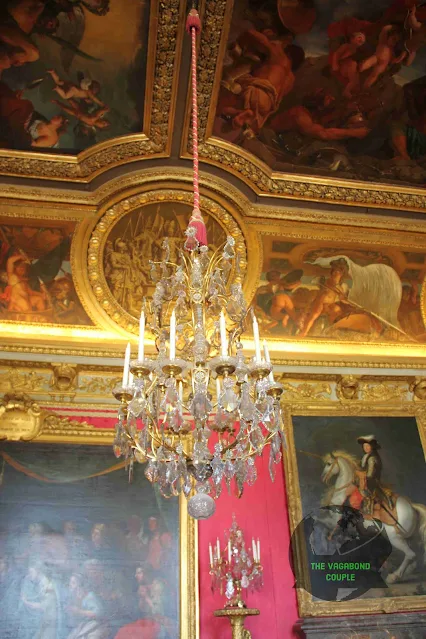
|
| Mars Room, King's Apartment |
The painting "Family of Darius at the feet of Alexander" (La Famille de Darius aux pieds d'Alexandre) by Charles Le Brun and Henri Testelin is displayed on a wall of the Mars Room.

|
| "The Family of Darius at the feet of Alexander" by Charles Le Brun and Henri Testelin |
The Mars Room was used for a variety of purposes during the reign of Louis XIV, including as a reception room for foreign dignitaries and as a place for the king to hold court. It was also used for balls, concerts and other social gatherings.

|
|
|
The Mercury Room (Bedroom of Louis XIV), King's Apartment
The Mercury Room (Salon de Mercure) is named after the Roman god Mercury. The room served as the ceremonial bedchamber of King Louis XIV. It is adorned with a magnificent décor that reflects the grandeur of the Palace of Versailles.

|
| The king's bed in Mercury Room |
The room's captivating ceiling fresco, painted by Jean-Baptiste de Champaigne, depicts Mercury on his chariot pulled by two roosters. Mercury, the god of trade (often seen at the entrances of caravanserais on the ancient silk road), arts and sciences and the messenger of the gods, is an apt figure for this room, symbolizing the king's intellectual and diplomatic prowess.

|
| Ceiling of Mercury Room, King's Apartment, Palace of Versailles |
The walls of the Mercury Room are adorned with gilded stucco panels, each depicting a different allegorical scene related to Mercury's attributes. These panels, crafted by renowned sculptor François Girardon, add to the room's rich symbolism and artistic splendor. There is a painting of a 13-year old King Louis XV in coronation attire by Hyacinthe Rigaud in the Mercury Room.

|
| Portrait of King Louis XV by Hyacinthe Rigaud, Mercury room, King's Apartment |
There is also a portrait of Queen Maria Karolina Zofia Felicja Leszczyńska (Queen Marie Leczinska) on a wall of the Mercury Room. Marie Leczinska was the wife of King Louis XV.

|
| Portrait of Queen Marie Leszczynska, Mercury Room, King's Apartment |
A grand fireplace, crafted from white marble and decorated with gilded bronze, stands as a focal point of the room. Its mantelpiece features a bas-relief sculpture of Mercury and a nymph, further emphasizing the room's connection to the god. Also in the Mercury Room is an ornate clock presented to Louis XIV by clockmaker Antoine Morand. Its internals are openly visible. The clock features a miniature of a victorious Louis XIV and puts on a mechanical show on a schedule.

|
| Antoine Morand's clock presented to Louis XIV |
The Mercury Room's furnishings, including luxurious velvet chairs and a magnificent bed, were originally made of solid silver, but were melted down in 1689 to finance the War of the League of Augsburg. Despite this loss, the room retains its opulent aura.
The Mercury Room holds historical significance as the place where Louis XIV's coffin was displayed from September 2 to 10, 1715, allowing the public to pay their respects to the Sun King.
The War Room
The War Room (Salon de la Guerre, also known as the King's Office - Cabinet du Roi) is located on the second floor of the palace's south wing at one end of the Hall of Mirrors (the Peace Room is at the other end). It was designed by Jules Hardouin-Mansart and completed in 1684.
The star attraction of the War Room is a large stucco bas-relief of Louis XIV on horseback crushing his enemy.

|
| Bas-relief of Louis XIV crushing the enemy |
The War Room was used by Louis XIV to plan and direct his military campaigns and is decorated with a variety of symbols of war and victory, including trophies of arms, cannons and Roman standards.
The ceiling is painted with a fresco depicting Victoria, the goddess of victory, crowning Louis XIV. The surrounding panels depict more scenes of Louis XIV trouncing the enemy.

|
|
|
The War Room is where Louis XIV made some of the most important decisions of his reign. It is also a reminder of Louis XIV's ambition to make France the most powerful country in Europe.

|
| View from the War Room into the Hall of Mirrors |
The Hall of Mirrors

|
| The Hall of Mirrors |
This iconic hall of mirrors (Galerie des Glaces), sometimes referred to as the hall of a thousand chandeliers and the hall of chandeliers, is a grand Baroque style gallery and one of the most emblematic rooms in the royal Palace of Versailles. The grandiose ensemble of the hall and its adjoining salons was intended to illustrate the power of the absolutist monarch Louis XIV. Located on the second floor (piano nobile) of the palace's central body, it faces west towards the Palace Gardens.
The Hall of Mirrors is 73 meters (240 ft) long and 10.5 meters (34 ft) wide. It is lined with 17 arches on each side, each of which on one side is filled with a mirror. The mirrors reflect the light from the windows and the chandeliers, creating a dazzling effect.

|
| The Hall of Mirrors |
The ceiling of the Hall of Mirrors is painted with a series of frescoes by Charles Le Brun. The frescoes depict the victories and accomplishments of Louis XIV.

|
|
|
The Hall of Mirrors was used for many important events, such as balls, banquets and diplomatic receptions. It has been the scene of events of great historic significance, including the Proclamation of the German Empire and the signing of the Treaty of Versailles ending World War I.
The Peace Room
Located between the Hall of Mirrors and the Queen's State Apartment, the Peace Room (Salon de la Paix) is decorated with a variety of symbols of peace and prosperity, including olive branches, cornucopia and figures of allegorical figures such as Abundance and Peace. It reflects the political and international importance of Versailles during this era.
The ceiling is painted with a fresco depicting Louis XIV bringing peace to Europe.

|
| Ceiling of the Peace Room |
The painting "Louis XV Giving an Olive Branch to Europe" by François Lemoyne holds a central place in the Peace Room as a powerful representation of the peace and diplomacy efforts during the reign of King Louis XV. The painting portrays King Louis XV extending an olive branch, a symbol of peace, towards a woman personifying the European continent. The gesture signifies France's commitment to diplomatic resolutions and harmony among European nations. Louis XV is depicted in a grand and noble manner, emphasizing his role as a peacemaker and his significance in shaping European politics during the 18th century.

|
| "Louis XV Giving an Olive Branch to Europe" by François Lemoyne |
The large fireplace below the painting is decorated with a relief of Mercury, the Roman god of commerce and peace and has two bronze statues of Louis XIV on either side. Three large windows illuminate the Peace Room with sunlight.

|
| Windows and ceiling of the Peace Room |

|
| Wall decoration between windows of the Peace Room |
A door at the Peace Room leads into the Queen's State Apartment.
 |
| Entrance door of Queen's Apartment from Peace Room (composite) |
The Queen's State Apartment
The chambers of the Queen's Apartment were the private residence of Marie Antoinette, wife of Louis XVI. The suite of rooms located on the second floor on the south side of the palace were originally built for Queen Maria Theresa (first wife of Louis XIV), but they have been occupied by a number of different queens and princesses over the centuries. It is made up of over 30 rooms including a bedroom, a drawing room, a dining room and a library. They are decorated in a more intimate and personal style than the rest of the palace.
 |
| Queen's Royal Bedchamber, Queen's Apartment (composite) |
The apartment was originally decorated in the Louis XIV style, but it was remodeled and decorated to the taste of each queen. The apartment is decorated with a variety of materials, including silk, velvet and lace. The furniture is made of mahogany and rosewood and inlaid with intricate carvings. The walls are covered with tapestries and paintings.
The apartment was a private space for the queens of France and their families. They would use it to relax, entertain guests and meet with their advisors. The apartment is also a reflection of taste and style of the queens. They were patrons of the arts and they wanted their apartment to be a reflection of the latest trends in fashion and design.
Queen's Royal Bedchamber, Queen's Apartment
The queen's bedroom (Chambre de la Reine) features a lavish four-poster bed and walls adorned with fine silk and decorated with delicate floral patterns. Elaborate gilding can be seen on the wooden paneling and trim. The bed itself, which was a focal point of the chamber, was ornate and canopied, reflecting the queen's status.
 |
| Queen's Royal Bedchamber, Queen's State Apartment |
The ceiling of the Queen's Bedchamber was painted by Charles de La Fosse and features an allegorical representation of the four continents.

|
| Queen's Royal Bedchamber, Queen's State Apartment |
The Nobles' Room, Queen's Apartment
The Nobles' Room (Chambre des Nobles) is a large room in the Queen's State Apartment used for formal audiences and ceremonies, as well as for the Queen's Circle, a gathering of ladies of the court for conversation and entertainment.

|
| The Nobles' Room |
The room is decorated in a lavish Baroque style, with gilded paneling, marble columns and painted ceilings. Portraits of French queens and other members of the royal family are hung on the walls. The room also contains a number of pieces of furniture.

|
| The Nobles' Room |

|
| Ceiling of Nobles' Room, Queen's Apartment |
The Queen's Antechamber, Queen's Apartment
The Queen's Royal Table Antechamber (Antichambre de la reine) is a large room located between the Queen's Grand Salon and the Queen's Royal Bedchamber. It was used as a waiting room for guests who were invited to dine with the Queen at the Royal Table.

|
| Queen's Antechamber |
The antechamber was a place where the Queen could meet with her guests informally before dinner. It was also where the Queen could display her wealth and power. The room's lavish decoration and furnishings were designed to impress and intimidate visitors.

|
| Queen's Antechamber |
The Queen's Royal Table Antechamber was also used for other purposes, such as balls, concerts and theatrical performances. It was a popular venue for these events because of its size and its proximity to the Queen's Royal Bedchamber.

|
| Queen's Antechamber |
Queen Marie Antoinette of France and two of her Children
A painting of Marie Antoinette and her children by Elisabeth Vigée Le Brun is displayed on a wall of Queen's Antechamber. Marie Antoinette is depicted in the painting with her three surviving children: Marie Thérèse Charlotte, Louis Joseph and Louis Charles. The children are dressed in informal clothing and Marie Antoinette is wearing a simple red dress. The painting is set in a room with a chest and a curtain in the background leading into another room with long arched windows.

|
| "Marie Antoinette and her children" by Elisabeth Vigée Le Brun |
Commissioned by the French government in 1785 and completed in 1787, the painting was intended to portray Marie Antoinette as a loving mother and a devoted queen. However, it was also seen as a propaganda piece designed to improve Marie Antoinette's public image. The painting was exhibited at the Salon of 1787 where it was met with mixed reviews. Some people praised the painting for its beauty and its portrayal of Marie Antoinette as a loving mother. Others criticized the painting for its lavishness and its perceived glorification of the monarchy.

|
| "Marie Antoinette and her Children" by Élisabeth Vigée-Lebrun |
Despite the mixed reviews, the painting remains one of the most iconic images of Marie Antoinette. It is a masterpiece of portraiture and it offers a glimpse into the life of the French queen at the height of her power.
The Queen's Guard Room
The Queen's Guard Room (Salle de la Garde de la Reine) at the Palace of Versailles is the only room in the Queen's State Apartment to have retained its original decoration from the reign of Louis XIV. It is adorned with marble and paintings by Noël Coypel.

|
| Queen's Guard Room |
The room was used as a vestibule in which the officers in charge of the Queen's protection were posted. It was also a place where the Queen could meet with her guests informally before attending formal events in other rooms of her State Apartment.

|
| Queen's Guard Room |
One of the most notable features of the Queen's Guard Room is its marble fireplace. The fireplace is decorated with a relief sculpture of the Queen and her children and it is surmounted by a mirror. The fireplace is also flanked by two marble statues, one of Mars, the Roman god of war and the other of Minerva, the Roman goddess of wisdom.
It appears to us the room is undergoing renovation at the time of our visit.
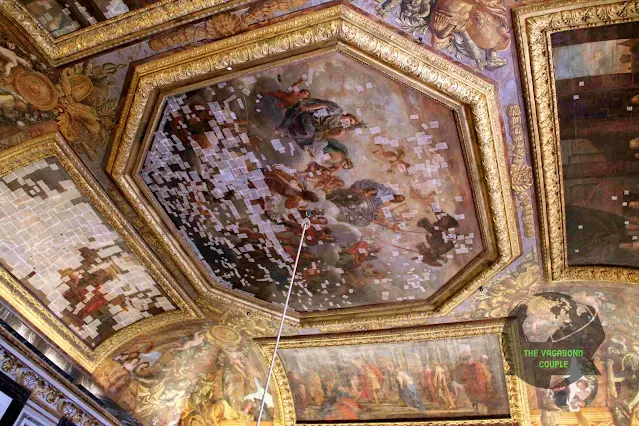
|
| Queen's Guard Room |
The Gallery of Battles
The Gallery of Battles (Galerie des Batailles) is a long, narrow hallway decorated with 33 paintings, 13 bronze tablets and 80 busts depicting major battles over 1,300 years of French history from the Battle of Tolbiac in 496 AD to the Battle of Waterloo in 1815.

|
| Gallery of Battles |
The gallery was commissioned by King Louis-Philippe I in 1833 and was completed in 1837. It was designed to glorify French military history and to promote national pride. The paintings were commissioned from a variety of artists, including Horace Vernet, Jean-Louis-Ernest Meissonier and François-Édouard Picot.

|
| Gallery of Battles |
The gallery is a striking example of 19th-century historical painting. The paintings are large and dramatic and they depict the battles in vivid detail. They are also notable for their patriotic themes, which emphasize the glory of French military victories.

|
| Gallery of Battles |
The Galerie des Batailles is a popular tourist attraction at the Palace of Versailles. It is a fascinating and informative gallery that offers visitors a glimpse into French military history.

|
| Gallery of Battles |
The Gardens of Versailles
The gardens of Versailles are just as impressive as the palace itself. They were designed by André Le Nôtre, one of the most famous landscape architects of all time.

|
|
Versailles Palace Gardens Photo: Jason via Flickr |
The gardens are divided into several different sections, each with its own unique design. Visitors can explore the gardens on foot or by taking a horse-drawn carriage ride.

|
|
Versailles Palace Gardens Photo: Dineshraj Goomany via Flickr |
The Grand Trianon and the Petit Trianon are two exceptional smaller palaces located within the main palace's expansive grounds. They are notable for their historical significance, architectural elegance and the role they played in the lives of French monarchs, most notably Queen Marie Antoinette. Visitors to the Palace of Versailles can explore both the Grand Trianon and the Petit Trianon in a unique opportunity to experience the private worlds of French monarchs and gain insight into their personal lives. Walking through these elegant palaces and their exquisite gardens, one can sense the contrast between the formality of the main palace and the intimacy and personal taste of the monarchs.
The name "Trianon" itself doesn't have a specific meaning beyond its association with these structures at the Palace of Versailles. The word "Trianon" is just a historical and architectural term used to describe these particular buildings and gardens within the larger palace complex.
The Grand Trianon: A Royal Retreat
The Grand Trianon, often referred to as simply the Trianon, is a palace designed in the Neoclassical architectural style. It was commissioned by King Louis XIV and built in 1687 by architect Jules Hardouin-Mansart as a place of retreat from the formalities of the Palace of Versailles. The Grand Trianon was constructed on the site of the former "Porcelain Tents," a collection of tents made from porcelain panels.

|
|
The Grand Trianon Photo: Byron T. via Flickr |
The Grand Trianon palace is characterized by its pink marble walls, elegant colonnades and harmonious architecture. It was designed to provide an intimate and refined escape for the monarch, away from the grandeur and rituals of the main palace. The interiors are adorned with exquisite decorative details further enhancing the sense of tranquility and luxury.

|
|
Peristyle of the Grand Trianon Photo: daryl_mitchell via Flickr |
The Grand Trianon played a central role in French history. It served as a residence for various French monarchs and emperors and was the location for significant events such as the signing of the Treaty of Tilsit between Napoleon I and Alexander I of Russia in 1807.
The Petit Trianon: Marie Antoinette's Refuge
The Petit Trianon is an even more intimate palace nestled within the Grand Trianon's gardens. It was built in the late 18th century during the reign of King Louis XV and is most famously associated with Queen Marie Antoinette, the wife of Louis XVI.

|
|
The Petit Trianon Photo: Jorge Láscar via Flickr |
Marie Antoinette used the Petit Trianon as a private retreat, allowing her to escape the strictures and formalities of court life. The palace, surrounded by charming gardens, provided the queen with a place where she could indulge her love for nature, art and simple living. She even had a small hamlet constructed nearby, known as the Queen's Hamlet, where she could play at being a shepherdess.

|
|
The Petit Trianon Photo: Jorge Láscar via Flickr |
The Petit Trianon is a beautiful example of the transition from Rococo to Neoclassical architecture. Its interiors are elegantly furnished and decorated, creating an atmosphere of refined simplicity.

|
|
The Petit Trianon Photo: Jorge Láscar via Flickr |
The Trianons are an essential part of any visit to Versailles, allowing you to delve deeper into the history, art and lifestyle of the French monarchy. They are a reminder of an era when even the most powerful of monarchs sought moments of respite, privacy and reflection within the enchanting embrace of these magnificent retreats.
The Queen's Hamlet
The Queen's Hamlet (Hameau de la Reine) is a picturesque and charming rural retreat located on the grounds of the Palace of Versailles. This delightful hamlet, a whimsical creation of Queen Marie Antoinette, represents a departure from the grandeur and formality of the palace and serves as a poignant symbol of the queen's desire for simplicity and escapism.

|
|
The Queen's House in Marie Antoinette's Hamlet Photo: Jorge Láscar via Flickr |
The Queen's Hamlet was born out of Marie Antoinette's desire for a place of refuge and relaxation away from the constraints of the court at the Palace of Versailles. In the late 18th century, the queen embarked on the project to create a rural village on the estate of Versailles. Her vision was to recreate the charm and simplicity of a rustic French village, complete with cottages, gardens and a working farm.
The Hamlet is designed in the rustic or "folly" architectural style, characterized by its quaint and idyllic appearance. The structures of the Hamlet are designed to resemble a peaceful countryside village, with thatched roofs, half-timbered facades and earthy colors. There are twelve cottages in total, including the Queen's House, the Billiard Room, the Boudoir and the Mill. Each building serves a specific purpose, with the Queen's House being Marie Antoinette's private residence within the Hamlet.
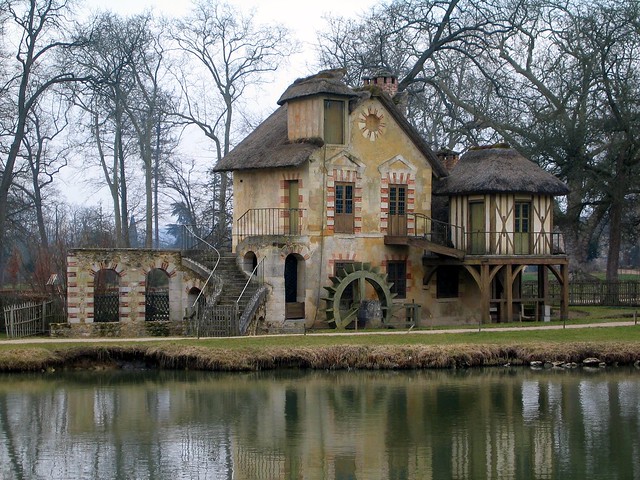
|
|
The Mill at Queen's Hamlet Photo: Sean Munson via Flickr |
Surrounding the cottages are lush gardens, orchards and a lake with a small island. The landscape was designed to evoke the feeling of a genuine rural setting, complete with meandering paths and footbridges.
Marie Antoinette was committed to maintaining the authenticity of her Hamlet, so she had a functioning farm established in the vicinity. The farm was home to various animals, including cows, sheep and goats. The queen and her guests would participate in the daily activities of the farm, further emphasizing the idyllic rural experience.
Definitive Exit
We catch a glimpse of the marble courtyard of the palace through the windows on our way out via the Definitive Exit (Sortie Definitive) across the Hall of the Kings of the main palace.

|
| Exit via Hallway of the Kings |
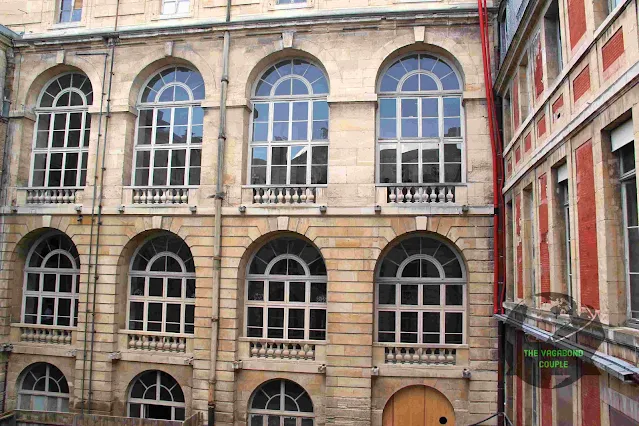
|
| Marble Courtyard |

|
| Access to the gardens of Versailles and the Definitive Exit (Sortie Definitive) |
Exiting the unforgettable Palace of Versailles, we take a train back to Paris and visit the Louvre and Eiffel Tower the next day. We then take a TGV Lyria fast train from Paris to our next stop of Zurich, Switzerland. That photo story is at France: Eurostar fast train from London through Channel Tunnel (Eurotunnel) to Paris, Château de Versailles, Musée du Louvre and La Tour Eiffel, TGV Lyria fast train from Paris to Zurich .
Note: Prose in this post received AI assistance from ChatGPT and Bard.






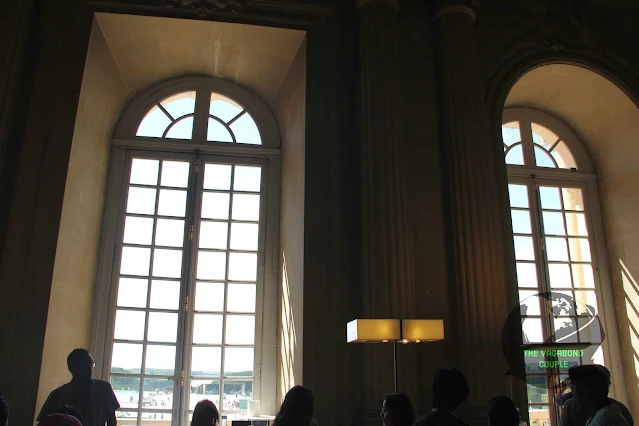


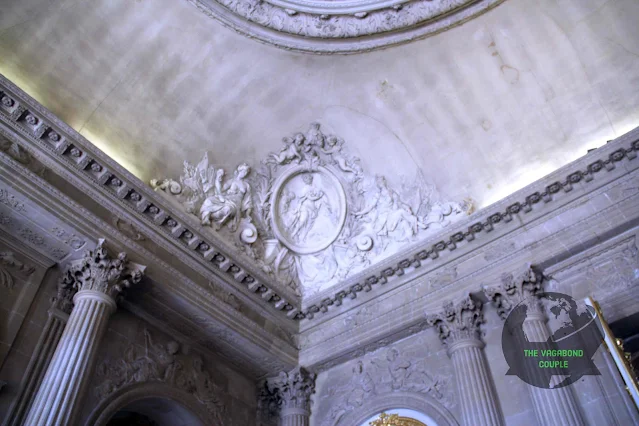

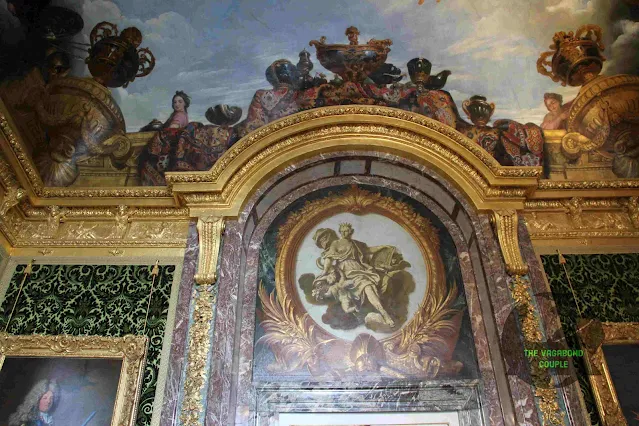
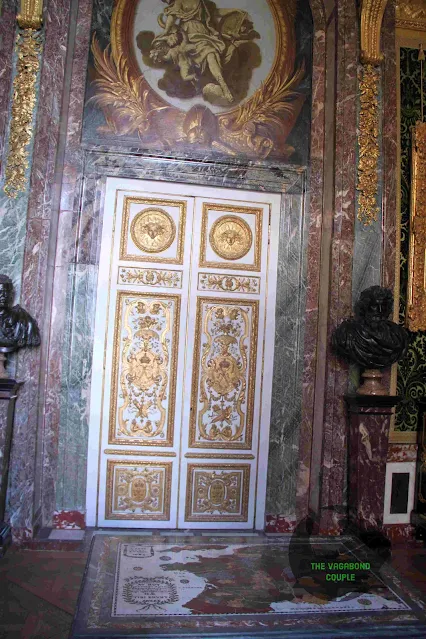

















0 comments